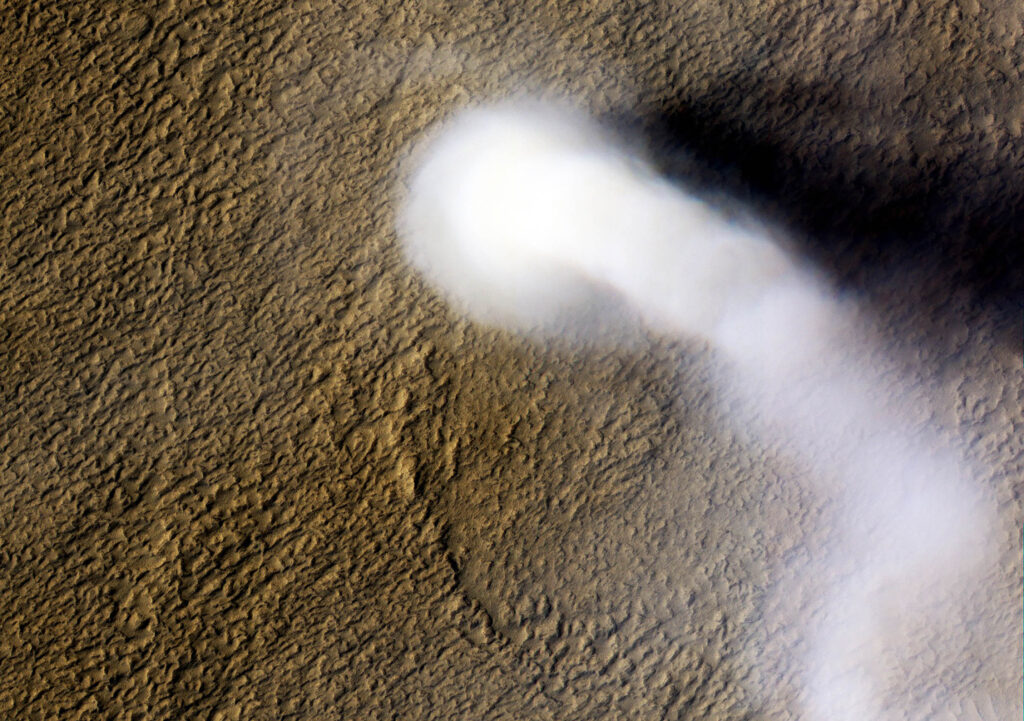
Scientists have tracked an astonishing 1,039 dust devils—tornado-like whirlwinds that dance across the Martian surface. This groundbreaking discovery was made possible by piecing together two decades of images from the European Space Agency’s (ESA) Mars Express and ExoMars Trace Gas Orbiter. By following the movement of these twisting columns, the team has produced the first comprehensive catalog that records both the locations and speeds of dust devils on Mars. This new dataset offers a fresh, planet-wide perspective on Martian winds and the dynamics of dust lifting.
The announcement comes as researchers strive to understand the intricate climate of Mars, where dust plays a pivotal role. Airborne particles on Mars dim sunlight during the day, trap heat at night, seed clouds, and can even loft water vapor high enough to escape into space. Without rain to cleanse the atmosphere, dust continues to circulate globally. Understanding the mechanics of dust lifting is crucial for decoding Martian weather and planning future missions, as dust can affect solar panels, cameras, and radiators on spacecraft.
Hunting for Dust Devils on Mars
Led by Valentin Bickel at the University of Bern, the research team utilized a neural network to identify dust devils in vast archives of orbital images. They analyzed data from Mars Express dating back to 2004 and ExoMars TGO images captured since 2016. The resulting public catalog pinpoints 1,039 dust devil events and measures direction and speed for 373 of them. The map reveals that dust devils can form almost anywhere on Mars, from crater floors to the flanks of giant volcanoes. However, they are particularly common in certain “source regions,” such as the fine-grained plains of Amazonis Planitia.
Mars Wind: Faster Than Expected
By tracking how far each whirlwind drifted between successive image channels, researchers recorded surface winds reaching up to 44 meters per second (about 158 miles per hour). These speeds surpass those measured by in situ rovers and, in many areas, exceed current Mars weather model predictions. Although the thin Martian atmosphere means these gale-force winds don’t have the same impact as they would on Earth, they are significant for dust lifting. The stronger-than-expected winds suggest that more material may be getting lofted into the atmosphere than models currently account for.
Mars’ Clock of Wind and Dust
Just like on Earth, dust devils on Mars adhere to a seasonal and daily schedule. They are most common in the spring and summer of each hemisphere, when surface heating is strongest. Activity peaks from late morning to early afternoon, roughly between 11:00 and 14:00 local solar time. Most whirlwinds last only a few minutes, but their collective effect is substantial, continuously feeding the atmosphere with fresh, fine dust.
Clever Techniques Reveal Hidden Motion
Neither Mars Express nor TGO was designed to measure wind. The innovative approach taken by researchers exploits how their cameras build images. Each picture is assembled from multiple narrow “channels” taken in quick succession—different colors and, in some cases, slightly different viewing angles. If the ground is still, the channels align perfectly. If something moves, such as a dust devil or cloud, tiny offsets appear between channels. These offsets, usually considered a nuisance, become a valuable tool for measuring motion.
On Mars Express, the delay between channels is 7 to 19 seconds, allowing scientists to observe a dust devil’s movement across the terrain and even detect small wobbles in its path. On TGO, paired views taken one second apart for color and 46 seconds apart for stereo enable researchers to track longer displacements, trading fine detail for reach.
Implications for Future Mars Landings
Integrating these wind measurements into global circulation models is expected to enhance forecasts of when and where dust is likely to lift and how it moves once airborne. This information is not just academic. Understanding prevailing winds at potential landing sites aids engineers in planning for local conditions. The research indicates how often solar-powered rovers may need to self-clean, how dust could abrade optics and radiators, and how parachutes and backshells will perform in the thin, gusty air.
ESA’s Rosalind Franklin rover, scheduled to land in 2030, is already being planned to avoid the peak global dust storm season. The catalog of dust devils is public and continues to grow as both orbiters image the Martian surface. With knowledge of hotspots and the times when dust devils are most likely to appear, researchers can target observations more effectively.
“Dust devils make the normally invisible wind visible,” Bickel said. With this work, scientists have transformed fleeting signatures from curiosities in rover albums into data points woven into a global tapestry.
From climate models to landing plans, from solar-panel maintenance to cloud formation, Mars’ smallest storms are providing insights into how the entire system breathes. The full study is published in the journal Science Advances.
Like what you read? Subscribe to our newsletter for engaging articles, exclusive content, and the latest updates. Check us out on EarthSnap, a free app brought to you by Eric Ralls and Earth.com.





